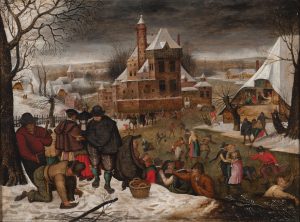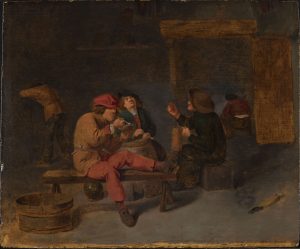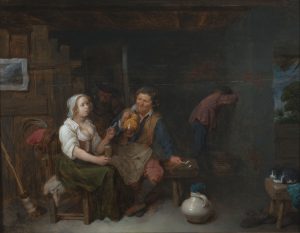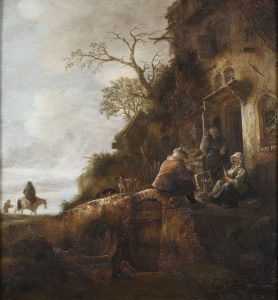The works shown here are considered “genre” paintings. This term, translating as “kind” or “type,” was introduced in the eighteenth century to refer to compositions with anonymous human figures that did not fall within other established categories, such as biblical or mythological scenes. Genre incorporated many topics of everyday life, yet the examples shown here all depict rural subjects.
Scenes of peasant merrymaking were first popularized by Pieter Brueghel the Elder (c. 1525/30–1569), who depicted countryside living and feasting in numerous prints as well as large-scale paintings. Due to continued demand for his works, his son Pieter Brueghel II (1564–1638) was able to run a successful business producing works in a similar style, such as Winter Landscape with Ice-Skaters. This painting is one of at least fifteen different versions of the same composition.
An important innovator of the tradition was Adriaen Brouwer (c. 1605–1638), who focused on the depiction of interiors and the smoking of tobacco—then a relatively new phenomenon—and this was followed by artists such as David Ryckaert III (1612–1661). Their work was produced for an urban market that associated a rural way of life with a more primal nature, and thus stronger susceptibility to carnal desires and vices. Art objects like these therefore served as markers of social distinction for affluent collectors.
It was likely a change in consumer taste that eventually caused depictions of peasant life to become less crude and more idyllic, as evidenced by the work of Isaac van Ostade (1621–1649). Set in a lush outside setting, Figures outside a Country House invites viewers to admire the effects of natural light on stone surfaces and foliage. In contrast to the inhabitants of the drab interiors in the work of artists like Brouwer, the men and woman depicted by Van Ostade are seen taking a brief mid-day break from their daily tasks. While these figures are thus portrayed in a more dignified manner, their purpose here remains the same—to function as a rural “other” from whom urban collectors could distinguish themselves.
The works shown here are considered “genre” paintings. This term, translating as “kind” or “type,” was introduced in the eighteenth century to refer to compositions with anonymous human figures that did not fall within other established categories, such as biblical or mythological scenes. Genre incorporated many topics of everyday life, yet the examples shown here all depict rural subjects.
Scenes of peasant merrymaking were first popularized by Pieter Brueghel the Elder (c. 1525/30–1569), who depicted countryside living and feasting in numerous prints as well as large-scale paintings. Due to continued demand for his works, his son Pieter Brueghel II (1564–1638) was able to run a successful business producing works in a similar style, such as Winter Landscape with Ice-Skaters. This painting is one of at least fifteen different versions of the same composition.

An important innovator of the tradition was Adriaen Brouwer (c. 1605–1638), who focused on the depiction of interiors and the smoking of tobacco—then a relatively new phenomenon—and this was followed by artists such as David Ryckaert III (1612–1661).


Their work was produced for an urban market that associated a rural way of life with a more primal nature, and thus stronger susceptibility to carnal desires and vices. Art objects like these therefore served as markers of social distinction for affluent collectors.
It was likely a change in consumer taste that eventually caused depictions of peasant life to become less crude and more idyllic, as evidenced by the work of Isaac van Ostade (1621–1649).

Set in a lush outside setting, Figures outside a Country House invites viewers to admire the effects of natural light on stone surfaces and foliage. In contrast to the inhabitants of the drab interiors in the work of artists like Brouwer, the men and woman depicted by Van Ostade are seen taking a brief mid-day break from their daily tasks. While these figures are thus portrayed in a more dignified manner, their purpose here remains the same—to function as a rural “other” from whom urban collectors could distinguish themselves.